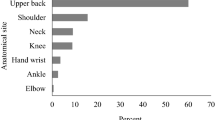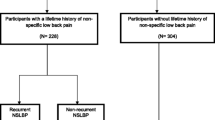Abstract
Studies describing risk indicators of low back pain (LBP) have focused on adults, although the roots of LBP lie in adolescence and early adulthood. The objective of the present study was to assess the lifetime occurrence and risk indicators of LBP in young adult males. The survey sample comprised 7,333 male conscripts (median age 19), of which 7,040 (96%) answered a questionnaire during the first days of their conscription. The outcome was lifetime LBP prompting at least one visit to a physician. Associations between 18 background variables and LBP were analysed by logistic regression. Altogether 894 (12.7%) respondents reported LBP. Health status was a strong determinant of LBP. The strongest individual risk indicators for LBP were having two or more other than back-related diseases diagnosed by a physician during past year (OR 2.0; 95% CI 1.6–2.5), below-average self-perceived health (OR 1.6; 95% CI 1.3–2.0) and use of smokeless tobacco (OR 1.4; 95% CI 1.2–1.7). Socioeconomic status was not associated with LBP and health behaviours only weakly. The strongest risk indicators for LBP were related to health problems. Of the socioeconomic background factors, none were associated with LBP. It is evident that LBP is associated with other health problems as well, indicating that its background may be multifactorial. This presents challenges for prevention programme planning and implementation. Longitudinal cohort studies are urgently needed to enhance understanding of adolescent risk indicators of LBP.
Similar content being viewed by others
References
Balague F, Troussier B, Salminen JJ (1999) Non-specific low back pain in children and adolescents: risk factors. Eur Spine J 8:429–438
Burton AK, Clarke RD, McClune TD et al (1996) The natural history of low back pain in adolescents. Spine 21:2323–2328
Feldman DE, Shrier I, Rossignol M et al (2001) Risk factors for the development of low back pain in adolescence. Am J Epidemiol 154:30–36
Hakala P, Rimpela A, Salminen JJ et al (2002) Back, neck, and shoulder pain in Finnish adolescents: national cross sectional surveys. BMJ 325:743
Harreby M, Kjer J, Hesselsoe G et al (1996) Epidemiological aspects and risk factors for low back pain in 38-year-old men and women: a 25-year prospective cohort study of 640 school children. Eur Spine J 5:312–318
Heir T, Glomsaker P (1996) Epidemiology of musculoskeletal injuries among Norwegian conscripts undergoing basic military training. Scand J Med Sci Sports 6:186–191
Hellsing AL, Bryngelsson IL (2000) Predictors of musculoskeletal pain in men: A twenty-year follow-up from examination at enlistment. Spine 25:3080–3086
Hestbaek L, Larsen K, Weidick F et al (2005) Low back pain in military recruits in relation to social background and previous low back pain. A cross-sectional and prospective observational survey. BMC Musculoskelet Disord 6:25
Hestbaek L, Leboeuf-Yde C, Kyvik KO et al (2006) The course of low back pain from adolescence to adulthood: eight-year follow-up of 9600 twins. Spine 31:468–472
Kujala UM, Taimela S, Erkintalo M et al (1996) Low-back pain in adolescent athletes. Med Sci Sports Exerc 28:165–170
Leboeuf-Yde C, Kyvik KO (1998) At what age does low back pain become a common problem? A study of 29,424 individuals aged 12–41 years. Spine 23:228–234
Leboeuf-Yde C (1999) Smoking and low back pain. A systematic literature review of 41 journal articles reporting 47 epidemiologic studies. Spine 24:1463–1470
Leboeuf-Yde C (2000) Alcohol and low-back pain: a systematic literature review. J Manipulative Physiol Ther 23:343–346
Miranda H, Viikari-Juntura E, Martikainen R et al (2002) Individual factors, occupational loading, and physical exercise as predictors of sciatic pain. Spine 27:1102–1109
Official Statistics of Finland (2003) Statistics Finland, Helsinki
Olsen TL, Anderson RL, Dearwater SR et al (1992) The epidemiology of low back pain in an adolescent population. Am J Public Health 82:606–608
Reynolds KL, White JS, Knapik JJ et al (1999) Injuries and risk factors in a 100-mile (161-km) infantry road march. Prev Med 28:167–173
Riihimaki H, Viikari-Juntura E, Moneta G et al (1994) Incidence of sciatic pain among men in machine operating, dynamic physical work, and sedentary work. A three-year follow-up. Spine 19:138–142
Salminen JJ, Pentti J, Terho P (1992) Low back pain and disability in 14-year-old schoolchildren. Acta Paediatr 81:1035–1039
Salminen JJ, Oksanen A, Maki P et al (1993) Leisure time physical activity in the young. Correlation with low-back pain, spinal mobility and trunk muscle strength in 15-year-old school children. Int J Sports Med 14:406–410
Taimela S, Kujala UM, Salminen JJ et al (1997) The prevalence of low back pain among children and adolescents. A nationwide, cohort-based questionnaire survey in Finland. Spine 22:1132–1136
Waxman R, Tennant A, Helliwell P (2000) A prospective follow-up study of low back pain in the community. Spine 25:2085–2090
West P (1997) Health inequalities in the early years: is there equalisation in youth? Soc Sci Med 44:833–858
World Health Statistics Annual (1999) World Health Organisation, Geneva
Zitting P, Rantakallio P, Vanharanta H (1998) Cumulative incidence of lumbar disc diseases leading to hospitalization up to the age of 28 years. Spine 23:2337–2343; discussion 2343–2344
Author information
Authors and Affiliations
Corresponding author
Rights and permissions
About this article
Cite this article
Mattila, V.M., Sahi, T., Jormanainen, V. et al. Low back pain and its risk indicators: a survey of 7,040 Finnish male conscripts. Eur Spine J 17, 64–69 (2008). https://doi.org/10.1007/s00586-007-0493-9
Received:
Revised:
Accepted:
Published:
Issue Date:
DOI: https://doi.org/10.1007/s00586-007-0493-9




